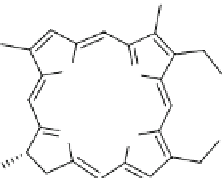Biomedical Engineering Reference
In-Depth Information
higher. The microenvironment in the double shell matrix of ORMOSIL could
explain this result. Those nanoparticles were however not tested
in vitro
.
Other types of silica particles have been used for the encapsulation of PS for
PDT. Wei and collaborators (Zhou et al.
2008
) have elaborated porous hollow silica
nanospheres of 130 nm diameter. The nanoparticles were prepared by careful
hydrolysis of N-(b-aminoethyl)-a-aminopropyl triethoxysilane catalyzed by ammo-
nia. The embedding rather than surface adsorption of hypocrellin A (Fig.
12
) was
demonstrated by fluorescence quenching experiments.
The particles were found to have good light and thermal stabilities. Such silica
nanoparticles were efficiently taken up by HeLa tumor cells and presented more
PDT efficiency than hypocrellin A. Higher
1
O
2
generation quantum yield was found
for the encapsulated PS than for free hypocrellin A.
The same collaborators later reported (Zhou et al.
2010
) the preparation of hypo-
crellin A nanoparticles by reprecipitation followed by encapsulation of these par-
ticles using N-(b-aminoethyl)-a-aminopropyl triethoxysilane to form 110 nm silica
nanovehicles. The resulting embedded hypocrellin A also showed superior light-
stability and singlet oxygen generation ability than free hypocrellin A. Fluorescence
images of Hela cells demonstrated the active cellular uptake of the drug-doped
nanovehicles into the tumor cells. As the authors evidenced a mitochondria local-
ization, light irradiation led to its membrane photodestruction.
In 2003, the Prasad group also prepared ORMOSIL nanoparticles for the entrap-
ment of 2-devinyl-2-(1-hexyloxyethyl)pyropheophorbide (HPPH, Fig.
13
), a pho-
tosensitizer in phase I/II clinical trials for oesophagal cancer (Roy et al.
2003
).
O H
OMe
Me
MeO
MeO
OH
Fig. 12
Hypocrellin A
(Reproduced by permission
of The Royal Society of
Chemistry)
COCH
3
OMe
O
OH
OC
6
H
13
NH
N
H
N
HN
Fig. 13
2-Devinyl-2-(1-hex-
yloxyethyl)pyropheophorbide
(HPPH) (Reproduced by per-
mission of The Royal Society
of Chemistry)
HO
2
C
H
O







Search WWH ::

Custom Search